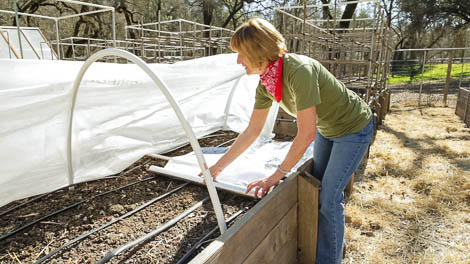Create the climate your plants want in your garden. Want to make it warmer in the fall and winter? Cooler in the summer? It takes just a few hours to get started for year-round growing.
Step 1: Add a Framework

The framework for dealing with the different seasons really is a frame. You'll need to create a supporting structure to hold up a variety of fabrics over your plants. In our video on fall planting, Tricia shows the permanent metal frame she built over her raised beds. If you prefer a removable framework you can use our curved pieces of wire for hoops -- simply sink each end 1 foot into your garden soil, spacing the wire supports 4 to 6 feet apart.
How to Make a Low Tunnel
To make a taller curved hoop or a low tunnel:
- Use 10 foot lengths of PVC pipe for the arches.
- Choose rebar that fits within your PVC pipe. Stabilize the pipe by pounding 1 foot pieces of rebar into the ground at 4 to 6 foot intervals along the sides of your garden bed. Leave 6 inches of rebar above the ground, and pair it with a matching piece on the opposite side of the bed.
- In late summer, slip the PVC pipes over the rebar to create the tall hoops.
- When warm weather returns in the spring, remove and store the pipes or leave them in to support any shade cloth you may use during the hot summer months.
- If you have raised beds with wooden sides you can make permanent PVC pipe arches by attaching the pipes to the outside of the beds
- Another option is to make a rectangular framework of PVC pipe. We have snap fittings to connect the lengths of pipe. Just check your pipe diameter and look at our selection of 3-way, 4-way, 5-way, and slip T connectors. This framework can be dismantled for the warm season, or left in place year-round, anchored by rebar.

Step 2: Adding a Covering
Shade cloth-to keep it cool
If your soil temperature is not cool enough, water the soil thoroughly to lower the temperature, and install shade cloth on your structure. Clamp the shade cloth in place, then check the soil temperature daily until it is cool enough to plant your seeds. Shade cloth is another great way to reduce the occurrence of sun scald on your tomatoes or peppers.
Floating row covers-to keep it warm
Here is a quick overview of the different weights of Agribon row covers we carry, and their uses. The Agribon can provide varying degrees of frost protection, from AG-19 to AG-70 as well as providing a barrier to insects with the lightest weight Agribon row cover, AG-15.
Greenhouse plastic-to keep it warmer
Add extra warmth to your garden bed, as cold weather approaches, with greenhouse plastic. Another technique used by Eliot Coleman (farms in Maine) is to use a second layer of frost protection in very cold temps. He uses a layer of floating row cover supported by wire hoops over plants in his greenhouse. Want more information about growing in the winter? You can't go wrong with The Winter Harvest Handbook by Eliot Coleman. The famed organic farmer raises crops through the winter in Maine of all places. With typical enthusiasm, Coleman shares practical advice about season-extending structures and techniques.

Step 3: Secure the fabric
Any fabric draped over a framework needs to be secured with clamps or clips. We have aluminum or plastic rowcover clamps to hold fabric onto the structures. To tie the edges of the fabric down to the ground, use our Clip-It (for shade cloth) or Row Cover Clips (for row cover), and secure them in the soil with Ground Staples. High winds can play havoc with row covers, so when that becomes a factor in your weather add extra ballast with bags of gravel along one side of your row. Weigh down the other side with boards (for easy removal when you want to harvest or check on your vegetables). Or another secure way to hold down your row cover, greenhouse plastic (Tufflite) or shade cloth is to add an aluminum rowcover clamp over your plastic snap clamps. It provides a super tight connection over your PVC pipe.
Step 4: Check soil temperature
You may be able to skip the late-summer, soil-cooling step if your soil is a comfortable temperature for the seeds you'll be planting. Most seeds need a temperature of 75°F to 90°F to germinate. Look at your seed packet to see the soil temperature ranges for your seeds, then test the soil temperature at various places in your garden bed with a soil thermometer.
With a few helpful tools, you can grow your garden year round!
For more information on extending your season and protecting the garden from hail, see our companion article in the Resource Center.


3 comments
You can put it out in the sun, let it heat up, it should bend better. I have personally used the regular pvc and also the schedule 40 pvc (usually gray). Found that securing with the pipe clamps with two screw attachments works best.
I often see pvc pipe arched over hoop houses, including one in a video here over a 4′×8′ raised bed. How do you get VC pipe to bend at such a sharp curve? WhenI shop for them, the salesman says it won’t bend like that.
If you have problems with birds eating your strawberries (like I do!) you can also use bird netting over low or high hoops and secure it with the clips.